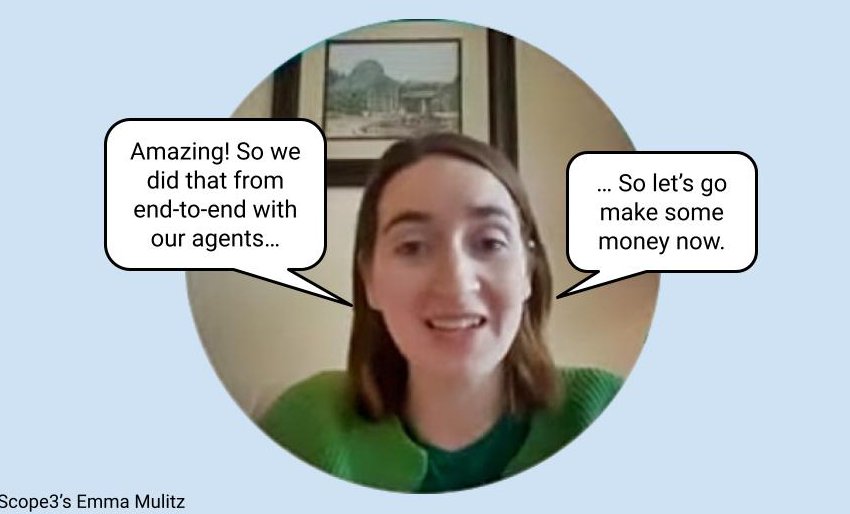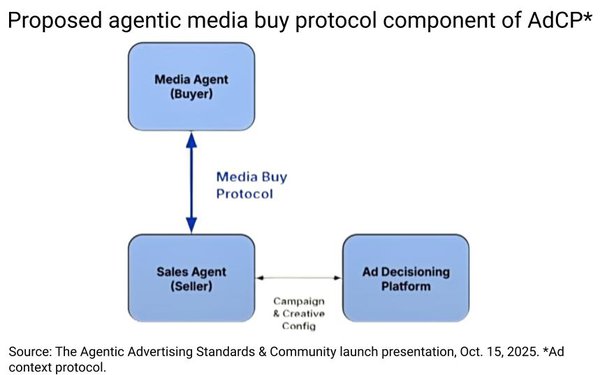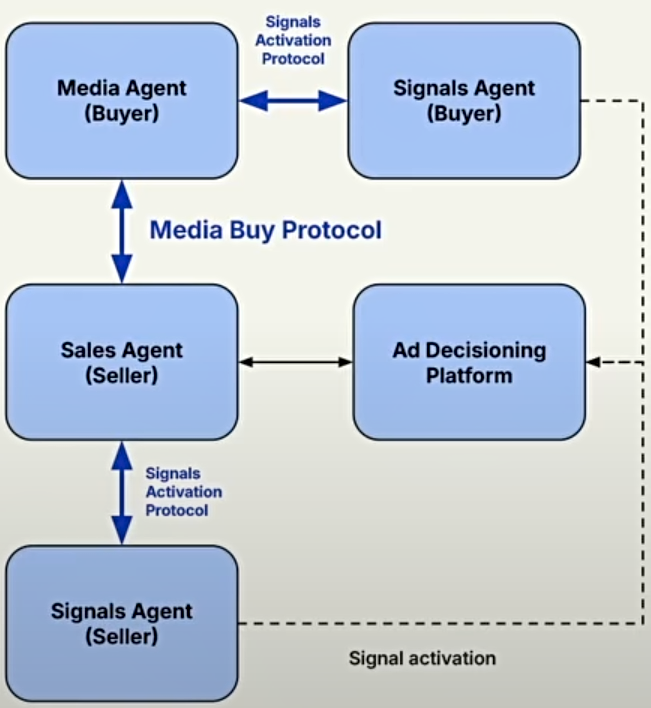As far as ad industry digital media-buying milestones go, Wednesday's
first-ever agentic media buy may or may not be up there with the industry's first-ever digital banner ad buy, but according to its organizers, it had the very same message as the future-looking
AT&T ad served nearly 31 years ago to the day on HotWired.com: "You will."
"It felt like you were watching the first banner ad being served," quipped long-time digital ad native Adam
Broitman, now a partner in the Marketing and Sales Practice at management consulting firm McKinsey & Co., who also is a member of the fledgling "Agentic Advertising Standards & Community,"
which hosted the live agent-to-agent (A2A) media buy via Zoom for anyone in the industry to watch live, in real-time.
While the agentic buy appeared to be a closed-loop order placed between
carbon advertising tagging platform Scope3 and publishing ad server Swivel
utilizing only LG Ads programmatic inventory, it was conducted live utilizing AI agents on both ends -- with a bit of fine-tuning and approvals from the two humans implementing the agentic buy: Scope3
Co-Founder and Lead Engineer Emma Mulitz and Swivel co-founder and CEO Joe Hirsch.
advertisement
advertisement
"All this orchestration is done by agents," Hirsch noted -- setting up the buy using a buyer agent created by
Scope3 on one end and the seller agent on the Swivel side, adding: "It's a real demonstration. And it also includes a real publisher -- our publishing partner, LG Ads."
Scope3's Mulitz said
she created a "brand agent" representing a non-alcoholic drink brand dubbed "Ematini," which appeared to be a made-up product used to demonstrate the agentic buying process.
Watch the video
above near the midpoint to see the end-to-end agentic buy, including the brief, the setup, the back-and-forth of fine-tuning the audience, and selecting the inventory, making a proposal, approving it,
the creative asset created and uploaded to the server, and completing the transaction -- but the important part is that it was a real, transactional buy. Money got exchanged in the end.

You can read more about the announcement in my colleague Laurie Sullivan's coverage of the new agentic advertising protocol being
championed by the organizers -- a coalition of mostly supply-side/ad-technology companies led by Scope3, including an agentic workflow schematic of the overall AdCP (advertising context protocol). But
I'm delineating its two components -- the agentic media buy protocol and the agentic signals activation protocol below, because, you know, this is a Planning & Buying Insider column,
so it should be relevant to you readers.
But some quick backstory notes first, and then an observation for historical overall industry perspective and relevance.
The agentic ad
industry has had many evangelists in the past few years, but the guy who really got this going was Scope3 CEO and Co-Founder Brian O'Kelley, who previously helped create the industry's programmatic
media-buying infrastructure as a founder of AppNexus, which he sold for lots of money and moved on to decarbonizing the digital ad world vis a vis Scope3.
Along the way, O'Kelley has made
agentic media buying his passion project, and you can read about that in his many posts on his LinkedIn page.
The
important thing is that he has been a driving force in the development of the proposed protocol and is now part of a coalition trying to make it a reality, and is reaching out to the ad industry at
large to do that.
There are some demand-siders in the mix for sure. Wednesday's presentation begins with a heartfelt pitch from Butler/Till CMO Amanda DeVito, and it ends with an equally
impassioned one from Luma Partners' Terry Kawaja.
Like AT&T's first-ever banner ad buy, the milestone moment has many authors, as I'm sure the agentic ad buy will as well. But just giving
some credit where credit's due here and giving a shoutout to O'Kelley for being the over-the-top driving force on this one.
Others are not so sanguine.
"My
immediate reaction was they're just talking about doing guaranteed buys and insertion orders, so we're just going back to the basics with the most advanced technology we've ever had in the history of
humanity," quipped MadConnect CEO Bob Walczak, adding: "Don't get me wrong, I am not a skeptic. I think this is an
important start to a conversation that is going to take the next five years-plus to evolve. This is the starting point."
"In the end, it's not that sexy," added McKinsey's Broitman, noting:
"What we're talking about here is workflow automation. It just happens to be agentic."
For any buyers and planners reading this or watching the video of Wednesday's A2A media buy, I'm sure
you've got some questions of your own vis-a-vis the agentic part, like whether you chose a sustainable career path.
To that point, MadTech's Walczak offers some pragmatic advice: "This is a
new layer of automation and they need to lean into it and adopt it. And when [the agentic developers] talk about 'the human in the loop,' they are the humans in the loop. They are the ones
that are going to be the prompt engineers that ask the right questions to get the buy.
"A calculator is of no use if you don't know how to do math already. The media buyer already understands
the industry. They understand how to write the right prompts to execute the campaign. They are highly valuable in this situation, but automation is coming, so they need to lean in and adopt in order
to be successful."
Lastly, here's my own observation after nearly half a century covering ad-industry standards and protocols epochs -- pre- and post-digital. Unless they are true tripartite
efforts equally involving the advertiser, the agency and the sellers, at least one of those entities is looking to game the system.
Think JICs, which for you digital natives may be a foreign
acronym, but they are known in most parts of the world as joint industry committees composed equally of advertisers, agencies and media sellers who work together to define a common set of protocols --
usually media measurement -- that they can agree on as the basis of media-buying transactions. You know -- "currency."
In fact, the only major ad market in the world where that has not been
the case is the United States, which had many fits-and-false start JIC initiatives until a supply-side-controlled entity -- the TV networks-owned OpenAP joint venture -- kickstarted a U.S. version of
JIC.
I call it a U.S. version because unlike JICs in other markets around the world, this one was started by and its protocols defined by the sell-side, not the buy-side, although they have
since recruited many ad agency media buyers to be part of it. That said, OpenAP's U.S. JIC still does not have any actual advertisers represented on it.
My point is about understanding and
looking for hidden agendas in the development of protocols that define how a marketplace transacts, and while everyone has to ask "what's in it for me," the best industry standard protocols are ones
that work equitably for everyone participating in the marketplace -- something that at least aspires for information symmetry.
I liked the language used by the Agentic Advertising Standards
& Community in its coming-out party Wednesday, but any new protocol will only move the industry forward if all sides are represented equitably.
That means advertisers, agencies,
publishers, ad tech, and maybe some other stakeholders I'm not even considering yet (like maybe the consumer)?
If you pull that off, "you will" have your agentic advertising future.
Or
as Scope3's Mulitz said: "Let's go make some money now."


